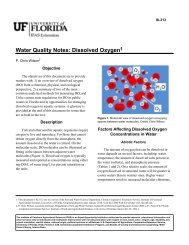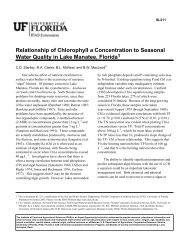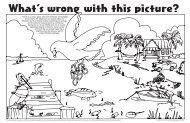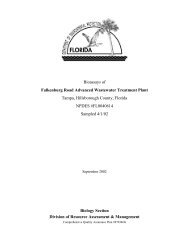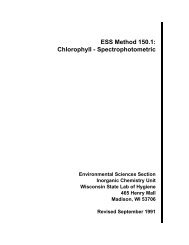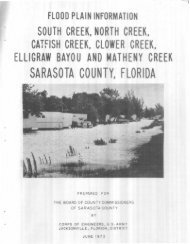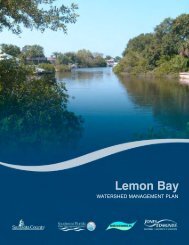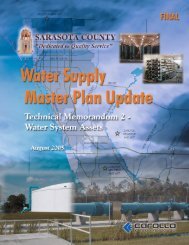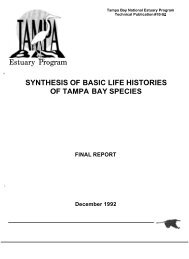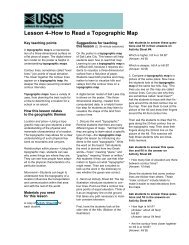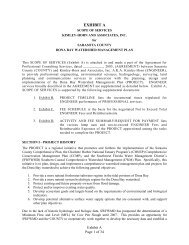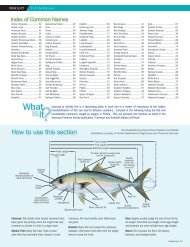Field Indicators of Hydric Soils in the United States - ITC
Field Indicators of Hydric Soils in the United States - ITC
Field Indicators of Hydric Soils in the United States - ITC
You also want an ePaper? Increase the reach of your titles
YUMPU automatically turns print PDFs into web optimized ePapers that Google loves.
<strong>Field</strong> <strong>Indicators</strong> <strong>of</strong> <strong>Hydric</strong> <strong>Soils</strong>landscape position this <strong>in</strong>dicator fails. It may benecessary to limit this <strong>in</strong>dicator to concave landscapes.TF8. Redox Spr<strong>in</strong>g Seeps. For test<strong>in</strong>g <strong>in</strong> LRR D. Alayer that has value 5 or more and chroma 3 orless with 2 percent or more dist<strong>in</strong>ct or prom<strong>in</strong>entredox concentrations as s<strong>of</strong>t masses or porel<strong>in</strong><strong>in</strong>gs (fig. 34). The layer is at least 5 cm (2 <strong>in</strong>)thick and is with<strong>in</strong> <strong>the</strong> upper 15 cm (6 <strong>in</strong>) <strong>of</strong> <strong>the</strong>soil surface.Redox Spr<strong>in</strong>g Seeps User Notes: This <strong>in</strong>dicator issimilar to Indicator F9 Vernal Pools. However, tomore fully correlate hydric soils to wetland vegetation,chroma 3 is <strong>in</strong>cluded <strong>in</strong> this <strong>in</strong>dicator as well as<strong>the</strong> redox concentrations portions <strong>of</strong> <strong>the</strong> depletedmatrix concept. This <strong>in</strong>dicator is not unique to depressionallandscapes; <strong>the</strong>refore, that requirement isdropped. As <strong>in</strong>ferred, this <strong>in</strong>dicator may occur <strong>in</strong>seeps and flow-through areas adjacent to spr<strong>in</strong>gs andupslope end <strong>of</strong> dra<strong>in</strong>ageways as well as depressionalseeps surrounded by uplands.TF9. Delta Ochric. For test<strong>in</strong>g <strong>in</strong> LRR O. A layer10 cm (4 <strong>in</strong>) or more thick that has 60 percentor more <strong>of</strong> <strong>the</strong> matrix with value 4 or more andchroma 2 or less, but has no redox concentrations.This layer occurs entirely with<strong>in</strong> <strong>the</strong> upper30 cm (12 <strong>in</strong>) <strong>of</strong> <strong>the</strong> soil surface.Figure 34. Indicator TF8 Redox Spr<strong>in</strong>g Seeps withprom<strong>in</strong>ent redox concentrations. Scale is cm.Delta Ochric User Notes: This <strong>in</strong>dicator is applicable<strong>in</strong> accret<strong>in</strong>g areas <strong>of</strong> <strong>the</strong> Mississippi RiverDelta.TF10. Alluvial Depleted Matrix. For test<strong>in</strong>g <strong>in</strong>LRRs M, N, and S. On frequently flooded floodpla<strong>in</strong>s, a layer with a matrix that has 60 percentor more chroma 3 or less with 2 percent redoxconcentrations as s<strong>of</strong>t iron masses, start<strong>in</strong>gwith<strong>in</strong> 15 cm (6 <strong>in</strong>) <strong>of</strong> <strong>the</strong> soil surface and extend<strong>in</strong>gto a depth <strong>of</strong> more than 30 cm (12 <strong>in</strong>).TF11. Reduced Vertic. For test<strong>in</strong>g <strong>in</strong> all LRRs thathave Vertisols and Vertic <strong>in</strong>tergrades. In Vertisolsand Vertic <strong>in</strong>tergrades, a positive reaction toalpha-alpha-Dipyridyl thata. is <strong>the</strong> dom<strong>in</strong>ant (60%or more) condition <strong>of</strong>a layer at least 4 <strong>in</strong>ches thick with<strong>in</strong> <strong>the</strong>upper 12 <strong>in</strong>ches (or at least 2 <strong>in</strong> thickwith<strong>in</strong> <strong>the</strong> upper 6 <strong>in</strong>) <strong>of</strong> <strong>the</strong> m<strong>in</strong>eral ormuck soil surface,b. occurs for at least 7 cont<strong>in</strong>uous days and 28cumulative days, andc. occurs dur<strong>in</strong>g a normal (with<strong>in</strong> 16–84% <strong>of</strong>probable precipitation) or drier season andmonth.Please follow <strong>the</strong> procedures and note <strong>the</strong> considerations<strong>in</strong> <strong>Hydric</strong> Soil Technical Note 8 (use<strong>of</strong> alpha-alpha-Dipyridyl).Reduced Vertic User Notes: The time requirementsfor this <strong>in</strong>dicator were identified from research <strong>in</strong>MLRA 150A <strong>in</strong> LRR T (Gulf Coastal Prairies); <strong>the</strong>se orslightly modified time requirements may be found toidentify wetland Vertisols and Vertic Intergrades <strong>in</strong>o<strong>the</strong>r parts <strong>of</strong> <strong>the</strong> Nation. These soils generally havea thick, dark surface horizon, but <strong>Indicators</strong> F4, F5,and F6 are <strong>of</strong>ten lack<strong>in</strong>g; possibly due to mask<strong>in</strong>g <strong>of</strong>redoximorphic features by organic carbon. Thesesoils are a special case <strong>of</strong> <strong>the</strong> Problem <strong>Soils</strong> withthick, dark A horizons listed <strong>in</strong> <strong>the</strong> 1987 Corps <strong>of</strong>Eng<strong>in</strong>eers Wetlands Del<strong>in</strong>eation Manual (EnvironmentalLaboratory, 1987).(430, FIHS, Ver. 5.01, March 2003) 23



